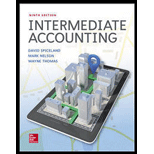
Concept explainers
(1)
Analysis of Financial Statements
A financial statement is the complete record of financial transactions that take place in a company at a particular point of time. It provides important financial information like assets, liabilities, revenues and expenses of the company to its internal and external users. It helps them to know the exact financial position of the company.
To identify: Name of the
(2)
To identify: The amounts for various items that are reported in the balance sheet as on January 30, 2016 of Corporation T.
(3)
To identify: The largest current asset and the largest current liabilities of the Corporation T.
(4)
To calculate: The
(5)
To comment: On Corporation T liquidity and long-term solvency position.
Want to see the full answer?
Check out a sample textbook solution
Chapter 3 Solutions
INTERMEDIATE ACCOUNTING (LL) W/CONNECT
- Horngren's Financial & Managerial Accounting: The Managerial Chapters, 8th Edition. Lily-Mae makes handheld calculators in two models: basic and professional. Lily-Mae estimated $812,500 of manufacturing overhead and 625,000 machine hours for the year. The basic model actually consumed 250,000 machine hours, and the professional model consumed 375,000 machine hours.Compute the predetermined overhead allocation rate using machine hours (MHr) as the allocation base. How much overhead is allocated to the basic model? To the professional model? Basic $325,000arrow_forward3. A corporation's working capital is calculated using which amounts? Total Assets And Total Liabilities Total Assets And Current Liabilities Current Assets And Current Liabilitiesarrow_forwardThe changes that occurred during a recent year in the accounts Retained Earnings and Treasury Stock will be presented in which financial statement? Balance Sheet Income Statement Statement Of Cash Flows Statement Of Comprehensive Income Statement Of Stockholders' Equityarrow_forward
- The amount spent for capital expenditures will be reported in which section of the statement of cash flows? Cash Provided/used In Financing Activities Cash Provided/used In Investing Activities Cash Provided/used In Operating Activities Supplemental Informationarrow_forwardWhich of the following will appear as a negative amount on a statement of cash flows that was prepared using the indirect method? A Decrease In Inventory An Increase In Accounts Payable An Increase In Accounts Receivable Depreciation Expensearrow_forwardWhich of the following will appear as a positive amount on a statement of cash flows that was prepared using the indirect method? An Increase In Accounts Receivable An Increase In Inventory A Decrease In Accounts Payable Depreciation Expensearrow_forward
 Accounting (Text Only)AccountingISBN:9781285743615Author:Carl Warren, James M. Reeve, Jonathan DuchacPublisher:Cengage Learning
Accounting (Text Only)AccountingISBN:9781285743615Author:Carl Warren, James M. Reeve, Jonathan DuchacPublisher:Cengage Learning Financial & Managerial AccountingAccountingISBN:9781285866307Author:Carl Warren, James M. Reeve, Jonathan DuchacPublisher:Cengage Learning
Financial & Managerial AccountingAccountingISBN:9781285866307Author:Carl Warren, James M. Reeve, Jonathan DuchacPublisher:Cengage Learning AccountingAccountingISBN:9781337272094Author:WARREN, Carl S., Reeve, James M., Duchac, Jonathan E.Publisher:Cengage Learning,
AccountingAccountingISBN:9781337272094Author:WARREN, Carl S., Reeve, James M., Duchac, Jonathan E.Publisher:Cengage Learning, Survey of Accounting (Accounting I)AccountingISBN:9781305961883Author:Carl WarrenPublisher:Cengage Learning
Survey of Accounting (Accounting I)AccountingISBN:9781305961883Author:Carl WarrenPublisher:Cengage Learning



